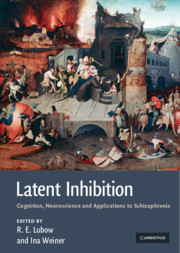Book contents
- Frontmatter
- Contents
- List of contributors
- Preface
- 1 A short history of latent inhibition research
- Current topics in latent inhibition research
- 2 Latent inhibition and extinction: their signature phenomena and the role of prediction error
- 3 Inter-stage context and time as determinants of latent inhibition
- 4 Latent inhibition: acquisition or performance deficit?
- 5 Latent inhibition and learned irrelevance in human contingency learning
- 6 Associative and nonassociative processes in latent inhibition: an elaboration of the Pearce–Hall model
- 7 From latent inhibition to retrospective revaluation: an attentional-associative model
- 8 Latent inhibition and habituation: evaluation of an associative analysis
- 9 Latent inhibition and creativity
- 10 The phylogenetic distribution of latent inhibition
- 11 The genetics of latent inhibition: studies of inbred and mutant mice
- 12 A comparison of mechanisms underlying the CS–US association and the CS–nothing association
- 13 The pharmacology of latent inhibition and its relevance to schizophrenia
- 14 Parahippocampal region–dopaminergic neuron relationships in latent inhibition
- 15 Latent inhibition and other salience modulation effects: same neural substrates?
- 16 What the brain teaches us about latent inhibition (LI): the neural substrates of the expression and prevention of LI
- 17 Latent inhibition in schizophrenia and schizotypy: a review of the empirical literature
- 18 A cautionary note about latent inhibition in schizophrenia: are we ignoring relevant information?
- 19 Latent inhibition as a function of anxiety and stress: implications for schizophrenia
- 20 Nicotinic modulation of attentional deficits in schizophrenia
- 21 Latent inhibition and schizophrenia: the ins and outs of context
- Summary and conclusions
- Index
- References
13 - The pharmacology of latent inhibition and its relevance to schizophrenia
from Current topics in latent inhibition research
Published online by Cambridge University Press: 04 August 2010
- Frontmatter
- Contents
- List of contributors
- Preface
- 1 A short history of latent inhibition research
- Current topics in latent inhibition research
- 2 Latent inhibition and extinction: their signature phenomena and the role of prediction error
- 3 Inter-stage context and time as determinants of latent inhibition
- 4 Latent inhibition: acquisition or performance deficit?
- 5 Latent inhibition and learned irrelevance in human contingency learning
- 6 Associative and nonassociative processes in latent inhibition: an elaboration of the Pearce–Hall model
- 7 From latent inhibition to retrospective revaluation: an attentional-associative model
- 8 Latent inhibition and habituation: evaluation of an associative analysis
- 9 Latent inhibition and creativity
- 10 The phylogenetic distribution of latent inhibition
- 11 The genetics of latent inhibition: studies of inbred and mutant mice
- 12 A comparison of mechanisms underlying the CS–US association and the CS–nothing association
- 13 The pharmacology of latent inhibition and its relevance to schizophrenia
- 14 Parahippocampal region–dopaminergic neuron relationships in latent inhibition
- 15 Latent inhibition and other salience modulation effects: same neural substrates?
- 16 What the brain teaches us about latent inhibition (LI): the neural substrates of the expression and prevention of LI
- 17 Latent inhibition in schizophrenia and schizotypy: a review of the empirical literature
- 18 A cautionary note about latent inhibition in schizophrenia: are we ignoring relevant information?
- 19 Latent inhibition as a function of anxiety and stress: implications for schizophrenia
- 20 Nicotinic modulation of attentional deficits in schizophrenia
- 21 Latent inhibition and schizophrenia: the ins and outs of context
- Summary and conclusions
- Index
- References
Summary
Latent inhibition refers to the observation that under specific conditions, nonreinforced preexposure (PE) to a stimulus retards the efficacy with which this stimulus is conditioned when paired with reinforcement, compared to a nonpreexposed (NPE) stimulus. The pharmacology of LI has been almost exclusively associated with the use of LI as an animal model of schizophrenia, and therefore largely overlaps the pharmacology of schizophrenia.
As detailed in our chapter on neural substrates of LI, the widely held notion that nonreinforced stimulus preexposure reduces attention to or salience of stimuli has served to link LI to attentional processing in schizophrenia. Specifically, because schizophrenia is characterized by an inability to filter out, or ignore, irrelevant or unimportant stimuli, abnormal LI was proposed as a tool for modeling deficient attention in schizophrenia (Solomon, Crider, Winkelman et al.,1981; Weiner, Lubow, & Feldon, 1981, 1984, 1988). Here we will focus on our use of LI for the development of pharmacological animal models related to schizophrenia and the identification of viable antipsychotic/anti-schizophrenia medications. Based on our initial pharmacological data, we adopted in our pharmacological investigations a view of LI that distinguished between the acquisition of LI (learning to ignore the nonreinforced stimulus in preexposure) and the expression of LI (subsequent expression of this learning in conditioning) (Weiner, Feldon, & Katz, 1987; Weiner et al., 1984, 1988). This view of LI has been elaborated in the switching model of LI (Weiner, 1990, 2003; Weiner & Feldon, 1997), and has guided our use of LI for modeling schizophrenia.
- Type
- Chapter
- Information
- Latent InhibitionCognition, Neuroscience and Applications to Schizophrenia, pp. 276 - 318Publisher: Cambridge University PressPrint publication year: 2010
References
- 1
- Cited by



